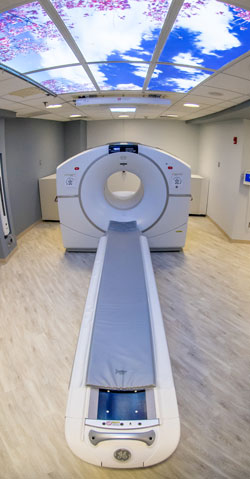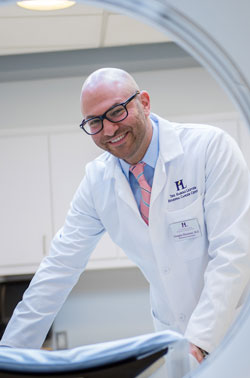Latest Technology at Leever
Posted on
GE Discovery™ MI DR PET/CT significantly improves diagnostic accuracy and reduces patient exposure to radiation by more than 50 percent.
There has never been a time in the history of cancer research when scientific breakthroughs and technological innovations have come at a more rapid and steady pace. It is a time of strengthening optimism, rising survival rates, and continuously improving treatment options for cancer patients. As these advances revolutionize the way we treat the disease, cancer centers are being challenged to invest in the new technologies that allow them to remain at the forefront of cancer care.

“When we opened our doors more than 15 years ago, we did so with an eye toward the future — with the understanding that we would continue to change and grow in ways that would allow us to remain on the cutting edge of cancer care and treatment,” says Kevin Kniery, executive director of The Harold Leever Regional Cancer Center. “Along with our Board of Directors and its members, Saint Mary’s Hospital, and Waterbury Hospital, we have done just that by continuously investing in new and emerging technologies. The evolution of our PET/CT center is an excellent example of our commitment to our mission.”
Leever’s first PET/CT facility was a mobile unit, much like those at other facilities across the region. Then, in 2006, the Leever Cancer Center opened a new 4,000-square-foot PET/CT Imaging Center, one of a few such centers in the area, and the only dedicated PET/CT in a radiation oncology department in the state of Connecticut. Over the years, regular investments in system updates and processes continued to advance Leever’s capabilities, while laying the groundwork for a major renovation of the center, completed earlier this year. The work included the installation of a state-of-the-art, premium PET/CT system. The GE Discovery™ MI DR is built for speed and accuracy, employing an extremely high-sensitivity detector and the most innovative reconstruction technology available. The result: unparalleled resolution that can detect even very small lesions earlier in the life of the disease, and repeatable measurement accuracy from one exam to the next that may reduce CT dose by up to 60 percent with improved image quality.
“The new system offers patients two critical advantages,” notes Radiation Oncologist Jeffrey Bitterman. “The diagnostic sensitivity of the scan is much higher and exposes the patient to less than 50 percent of the radiation dose as compared to previous generation scanners. That means I can more accurately delineate the precise location of the tumor, which could change our treatment plan dramatically. That in turn means fewer side effects and better outcomes for patients!”
PET/CT images offer precise and detailed information about the exact location and metabolic status of a tumor. The combined clinical images provide important information for radiologists, dosimetrists, radiation oncologists, and surgical oncologists. They also offer information about the effectiveness of ongoing chemo or radiation therapy treatments, which allows doctors to accurately adjust to optimize effectiveness.
 “The PET/CT scanner plays a critical role in oncologic care,” says Dr. Douglas Housman, a radiation oncologist at Leever. “It is a critical component of diagnosis in a great number of disease sites. With regard to lung cancer, for example, PET/CT imaging is part of a standard of care; a critical component in establishing the extent of disease. The new system incorporates a more sensitive scanner that will allow us to see things earlier and perhaps intervene earlier to improve patient outcomes.”
“The PET/CT scanner plays a critical role in oncologic care,” says Dr. Douglas Housman, a radiation oncologist at Leever. “It is a critical component of diagnosis in a great number of disease sites. With regard to lung cancer, for example, PET/CT imaging is part of a standard of care; a critical component in establishing the extent of disease. The new system incorporates a more sensitive scanner that will allow us to see things earlier and perhaps intervene earlier to improve patient outcomes.”
In addition to the technological upgrades, the Imaging Center also got a facelift, with changes to the walls, floors, and ceilings.
“Aesthetically, the new room and the layout of the new area are quite pleasing and calming,” says Dr. Bitterman. “I’m a firm believer in the mind-body connection, so if our patients feel more comfortable in the renovated space, I think that can make for a more positive, pleasant experience overall.”
